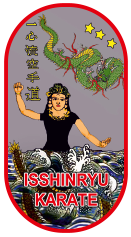HISTORY OF ISSHIN-RYU KARATE
Tatsuo Shimabuku
Shimabuku Tatsuo (島袋龍夫) (1908–1975) was born Shinkichi Shimabuku on September 19, 1908 in Gushikawa village, Okinawa. While "The four most widely recognized of Tatsuo Shimabuku's instructors are Chotoku Kyan, Choki Motobu, Chojun Miyagi, and Taira Shinken.
Shimabuku opened his first dojo in Konbu village and began teaching in late 1947 after being repatriated from Kyushu. Around this time, he adopted the name "Tatsuo," "Dragon Man. He taught in Tairagawa village and also in Koza City before deciding to teach in his house in about 1948. On January 15, 1956, he held a meeting and announced that he was naming his new style of karate Isshin-ryu. Shimabuku's number one student, Eiko Kaneshi, was at the meeting and he asked Shimabuku, "Why such a funny name?" Tatsuo replied, "Because all things begin with one. At the age of 50 (c. 1959) Shimabuku began studying kobudō, the art of traditional Okinawan weapons, under Shinken Taira. Kobudō weapons included were the sai, bo, and tonfa. He incorporated the kobudō that he had learned from Kyan and Taira into the Isshin-ryu system.
Features
Isshin-Ryu employs a vertical punch with the fingers tucked in and the thumb on top of the fist. Advantages vary with opinion, but it is usually taught that the thumb placement increases the stability of the wrist when punching, and that a vertical punch strikes with the same force at any range instead of at maximum extension as with a corkscrew style punch. Another advantage is that when punching, the thumb will not get caught on an object as opposed to having the thumb sticking up or out.
In Isshin-Ryu it is believed that the vertical punch is faster than the cork-screw punch: three vertical hand punches can be generated in the time of two cork-screw punches.
Isshin-Ryu arm blocks are performed today with the muscle at the intended contact point as opposed to other styles that block with the bone. By using the two bones and the muscle to form a block, less stress is created against the defender's arm, increasing the ability to absorb a strike.
The original arm blocks were taught with palm up, wrist bent, to form a trapping motion as well as to block and/or strike with the radius bone.
Isshin-Ryu kicks are primarily a "snapping" motion, as opposed to placing primary emphasis on thrusting and follow-through. Furthermore, Traditional Isshin-Ryu kicks are aimed almost entirely to the legs or groin. Nothing above the belt.


